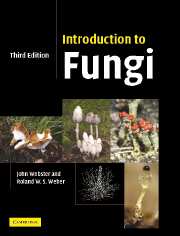Book contents
- Frontmatter
- Contents
- Preface to the first edition
- Preface to the second edition
- Preface to the third edition
- Acknowledgements
- 1 Introduction
- 2 Protozoa: Myxomycota (slime moulds)
- 3 Protozoa: Plasmodiophoromycota
- 4 Straminipila: minor fungal phyla
- 5 Straminipila: Oomycota
- 6 Chytridiomycota
- 7 Zygomycota
- 8 Ascomycota (ascomycetes)
- 9 Archiascomycetes
- 10 Hemiascomycetes
- 11 Plectomycetes
- 12 Hymenoascomycetes: Pyrenomycetes
- 13 Hymenoascomycetes: Erysiphales
- 14 Hymenoascomycetes: Pezizales (operculate discomycetes)
- 15 Hymenoascomycetes: Helotiales (inoperculate discomycetes)
- 16 Lichenized fungi (chiefly Hymenoascomycetes: Lecanorales)
- 17 Loculoascomycetes
- 18 Basidiomycota
- 19 Homobasidiomycetes
- 20 Homobasidiomycetes: gasteromycetes
- 21 Heterobasidiomycetes
- 22 Urediniomycetes: Uredinales (rust fungi)
- 23 Ustilaginomycetes: smut fungi and their allies
- 24 Basidiomycete yeasts
- 25 Anamorphic fungi (nematophagous and aquatic forms)
- References
- Index
- Plate section
19 - Homobasidiomycetes
- Frontmatter
- Contents
- Preface to the first edition
- Preface to the second edition
- Preface to the third edition
- Acknowledgements
- 1 Introduction
- 2 Protozoa: Myxomycota (slime moulds)
- 3 Protozoa: Plasmodiophoromycota
- 4 Straminipila: minor fungal phyla
- 5 Straminipila: Oomycota
- 6 Chytridiomycota
- 7 Zygomycota
- 8 Ascomycota (ascomycetes)
- 9 Archiascomycetes
- 10 Hemiascomycetes
- 11 Plectomycetes
- 12 Hymenoascomycetes: Pyrenomycetes
- 13 Hymenoascomycetes: Erysiphales
- 14 Hymenoascomycetes: Pezizales (operculate discomycetes)
- 15 Hymenoascomycetes: Helotiales (inoperculate discomycetes)
- 16 Lichenized fungi (chiefly Hymenoascomycetes: Lecanorales)
- 17 Loculoascomycetes
- 18 Basidiomycota
- 19 Homobasidiomycetes
- 20 Homobasidiomycetes: gasteromycetes
- 21 Heterobasidiomycetes
- 22 Urediniomycetes: Uredinales (rust fungi)
- 23 Ustilaginomycetes: smut fungi and their allies
- 24 Basidiomycete yeasts
- 25 Anamorphic fungi (nematophagous and aquatic forms)
- References
- Index
- Plate section
Summary
Introduction
Fungi included in the Homobasidiomycetes possess holobasidia, in contrast to the heterobasidia (phragmobasidia) of the Heterobasidiomycetes, rusts and smuts (see Chapters 21–23). The traditional classification of the Homobasidiomycetes, founded by the nineteenth century Swedish mycologist Elias Fries, was based on a number of different arrangements of the hymenium on the hymenophore. The most common types, shown in Fig. 19.1, are (A) agaricoid, i.e. gill-bearing (lamellate); (B) poroid, i.e. bearing pores instead of gills; (C) hydnoid, i.e. with a toothed or spiny hymenium; (D) clavate, with a club-shaped or coralloid fruit body, the outside of which is covered by the hymenium; (E) resupinate, i.e. with a flattened (corticioid) hymenium appressed to the underside of solid surfaces; and (F) epigeous or (G) hypogeous gasteroid or secotioid (non-ballistosporic) hymenophores (see Chapter 20). It has long been suspected that the different hymenial arrangements have evolved separately in unrelated fungal groups, i.e. that they represent examples of convergent evolution. They can be interpreted as different ways of maximizing the hymenial area for a given amount of fungal tissue (Pöder, 1983; Pöder & Kirchmair, 1995). Examples of similar hymenophore arrangements in unrelated fungi are seen in the tubular hymenia characteristic of Boletus (Fig. 19.21) and Trametes (Fig. 19.26) or the toothed hymenia found in the homobasidiomycete Hydnum (Fig. 19.1c) and the heterobasidiomycete Pseudohydnum (Fig. 21.9b).
- Type
- Chapter
- Information
- Introduction to Fungi , pp. 514 - 576Publisher: Cambridge University PressPrint publication year: 2007
- 2
- Cited by



